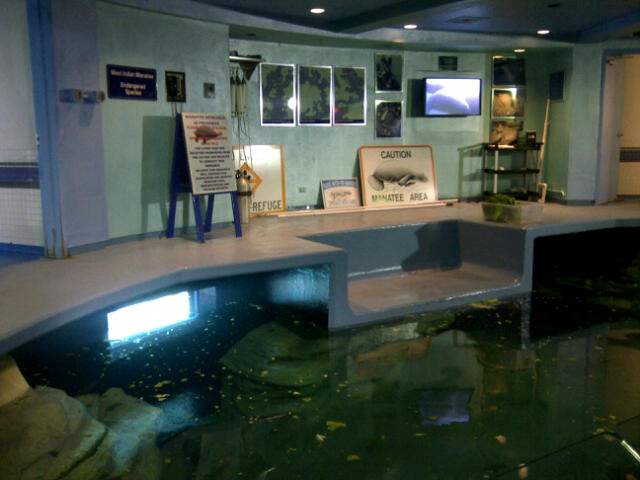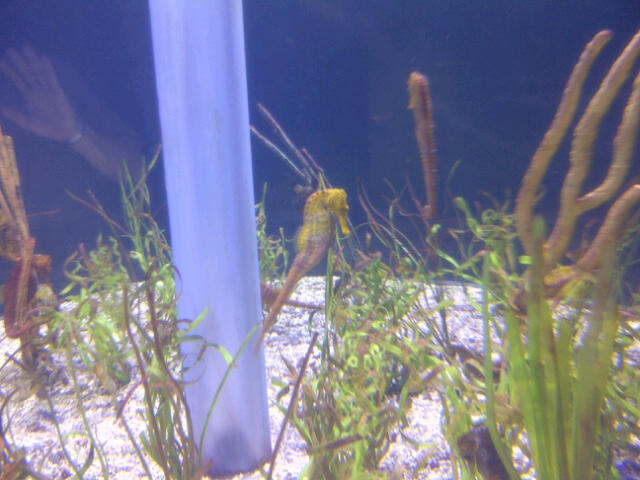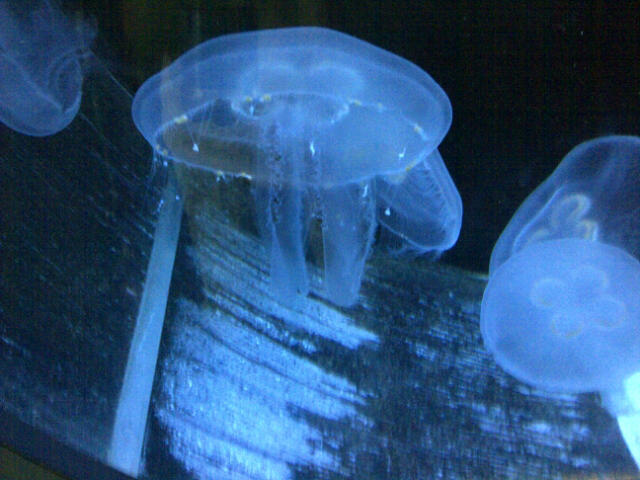May 24, 2012
Since our daughter’s internship at Disney’s Epcot is finished June 7, we decided to take advantage of the free passes employees get, which entitles them to bring six family members or friends into the park. This perk of Megan’s job is quite nice, when you consider that in 2012 the prices for admittance to Disney are steep: $135 for kids, $155 for adults – per day.
We initially planned to see two kingdoms – Epcot and Wild Kingdom- and hoped to work the visit around our 4 PM meet and greet backstage with the dolphins Megan has been around for the last six months. But two kingdoms in a single day is rather like planning to do 14 European countries in a weekend! We never got any farther than Epcot, and this world of the sea turned out to be plenty in a single day.
As you enter the park, a tremendous white ball dominates the skyline: Spaceship Earth. We did that ride years ago, and it would have been fun to do it again, but on the Friday before Memorial Day Weekend, there was a 90 minute wait outside, in the 90 degree heat. We opted for the air conditioned pavilion.
In the aquatic center, Megan took us to the dolphin and manatee area. Here’s where she spends anywhere from two to four hours a day, giving talks about manatees to whoever is congregated at the railing, hoping for a glimpse of one of the two manatees. Lou and Zail were injured by boats and brought to this facility to be rehabilitated. Lou is missing 90 percent of his dorsal fin and Zail is missing 60 percent.
They have their own area in the tanks, where every day they are each fed 100 heads of lettuce flown in from California. One of Megan’s jobs is preparing this lettuce for the two manatees, a job that turns her fingernails green. She showed us the huge industrial sized fridge where the lettuce is stored. That’s some of the lettuce floating on the surface of one of the tanks. I took this photo before Megan said, “Mom, you aren’t allowed to take any photos backstage.” I promptly slipped my phone in my back pocket, and secretly wondered how I could manage to take a few more. That sunlight, by the way, is from a skylight.
We walked back into the kitchen area, where interns and employees are preparing other types of foods for the four dolphins and hundreds of fish, turtles, and other creatures that live in the 5.7 million gallon saltwater tank. This tank is so large that the Spaceship Earth, in the photo at the top of the post, would fit inside of it. But I didn’t really get a sense of just what that means until we were taken to the top of the tank, for our meet and greet with the dolphins.
Before that happened, though, Megan took us into the office area shared by the trainers and interns. On one computer screen are live shots from security cameras that cover most of the backstage area of the aquarium, the area off limits to everyone except employees and their guests. We met Barb, who has been training dolphins since “before Megan was born,” and Leslie, who started in the field when she was just 17 (she’s now in her late 40s) and has been at Epcot for a decade. We had to leave our personal belongings in the office – which meant no cell camera! – and we had to remove all jewelry except watches.
Barb grabbed four buckets of fish and we followed her upstairs to the top of the enclosed tank. From this vantage point, the tank is utterly massive, but only 27 feet deep. It’s sectioned off, has small floating docks where the trainers and guests sit, and also has an area where the divers enter the tank several times a day to feed the various creatures. The salt in the water is carefully controlled and the entire tank is cleaned daily by – yes, you guessed it! – the interns. As Megan says, she has done about 50 scuba dives during her internship and is now an expert in cleaning up manatee poop.
So Barb stepped down onto the floating dock first, and Rob, Megan and I sat down on either side of her. The buckets of fish were to her right. It struck me that our meet and greet with the dolphins at Dolphins Plus in Key Largo, where Megan did another internship while in college, was much less structured. That facility is open to air and sunlight and the environment is more natural.
I started feeling sorry for these Epcot dolphins, I couldn’t help it. Yes, they are well cared for, always have enough to eat, have buddies to chum around with. But they never see sunlight or breathe outside air; the entire facility is air conditioned. At Dolphins’ Plus, you’re outside, at the edge of the Atlantic, the sun pouring down, and ocean water flows through the fences that keep the dolphins in the facility tanks. At Epcot, the salt and temperature of the water in the tank are carefully controlled, but it’s not ocean water.
The meet and greet with two of the dolphins was great. I love the way their skin feels, I love their wise eyes, their natural exuberance. They were beautifully trained in that they followed all of Barb’s hand signals. I could feel her genuine affection for these creatures and I understand that she and the other trainers and researchers are making important discoveries about dolphin cognition and language because of this facility. But it’s the equivalent of you or me being confined to a cave – a very pleasant cave where there’s plenty of food and a community of sorts and life is pretty good. Except. You and I never see sunlight, never feel the touch of outside air, never prepare our own food, never really own our lives. And every day at certain times we must do tricks for our keepers.
“Do dolphins sleep?” I asked, hoping these two did so they could dream.
“We think so – half their brain sleeps, the other half remains awake,” Barb said. “One researcher remained underwater with a mother dolphin 24/7 during the month after she gave birth. That dolphin never slept.”
“Can dolphins commit suicide” Rob asked, “by holding their breath?”
“No,” Barb replied with a firm shake of her head. “No way.”
Some people say otherwise.
The dolphins sent us on our way with a noisy, wet good-bye. We went back downstairs and for the longest time, I stood in front of one of the many aquariums, depressed about the dolphins, but spellbound by these guys:
And that’s the bottom line, really. Epcot is impeccable in its message about the conservation of aquatic life. Their exhibits ignite excitement and curiosity in the minds of kids – the next Jacques Cousteau or Jules Verne. But. Okay, I understand why the manatees are there. They were badly injured and were rescued. But with the dolphins, there has to be something better, more humane. How can any cognitive studies on these dolphins relate to dolphins in the wild?
Yet, on a deeper level, do dolphins, do all creatures, create their realities just as we humans do?
Did these dolphins choose lives at Epcot?













Re:
“Can dolphins commit suicide” Rob asked, “by holding their breath?”
“No,” Barb replied with a firm shake of her head. “No way.”
Some people say otherwise.
If you were to ask Flipper’s trainer Richard “Ric” O’Barry he would say otherwise
https://www.youtube.com/watch?v=4KRD8e20fBo
” Richard O’Barry started out capturing and training dolphins for the Miami Seaquarium and through the 1960s became the head trainer for the five dolphins who collectively played Flipper on the popular American TV show. When Kathy, the dolphin who most often played Flipper, died in O’Barry’s arms, he concluded that capturing, displaying and training dolphins to perform tricks was wrong. On Earth Day in 1970 he founded The Dolphin Project, an organization dedicated to educating the public about the plight of dolphins in captivity. He also pioneered work to demonstrate rehabilitation and release as a viable alternative for captive dolphins. O’Barry has since rescued and released over twenty-five captive dolphins in Haiti, Colombia, Guatemala, Nicaragua, Brazil, The Bahamas and the United States. ”
https://en.wikipedia.org/wiki/Ric_O%27Barry
https://vimeo.com/8017074
a sad commentary on the perspective of humans – i am always reminded with these kinds of stories of planet of the apes – perhaps it should be mandatory viewing for the humans!
and yes, much gratitude to megan and others with her dedication to helping our creature cousins!
PS……for any who may not know, the Navy may be testing the use of high-frequency underwater sound in Hawaii, off the California and Atlantic Coasts, and in the Gulf of Mexico soon, which is estimated to deafen 15,900 whales and dolphins over the next five years. Whales and dolphins depend on sound to navigate and live. I personally think that there are many humans, such as whatever geniuses in the Navy think this kind of warfare is necessary, who should be locked up instead of the dolphins. Here’s a petition circulating about this:
https://signon.org/sign/navy-under-water-sound?source=s.fwd.in&r_by=184143030
Thanks for mentioning this, Lauren. I read about it and neglected to put it with this post!
It’s a real travesty, for sure.
horrendous!
I don’t believe any creatures not raised in captivity would choose captivity, although it’s good that wounded creatures like the manatees can be provided for. Sadly, as the extinction of species continues to accellerate, places like Epcot will be the last refuge for many intelligences that are now still in the wild. Gratitude to Megan and her colleagues for their important jobs of educating the public, and helping people to find empathy for all of these endangered these beings…………
Choose to live at Epcot? That’s a difficult question to answer. I’d like to think so as that let’s us humans off the hook – otherwise the dolphins should be in the sea, in their natural environment doing what they choose to do. But, there again, are any of us truly free?
I meant “choose” in the soul sense. Humans shouldn’t be let off the hook where these dolphins are concerned.
I meant in the soul sense too – if it’s meant to be as a soul choice there’s not a lot we can do about them being captive – other than to treat them with the respect they deserve.
I agree with mathaddict. If dolphins choose captivity, then it is perhaps to help awaken in humanity, an instinctive primal desire to willingly release them into the wild – and to protect that wilderness.
Choose to be captive. Such a tragic thought, and yet there are instances in the lives of humans when OUR souls guide us to choose lives of captivity in one way or another, as a means of resolving issues and learning or teaching lessons. If these glorious mammals choose captivity, I hope it’s chosen as a means of teaching humans the lessons we need to learn about unconditional love and the sanctity of all life. A life without Sunshine and fresh air. I just cannot imagine. Cannot.